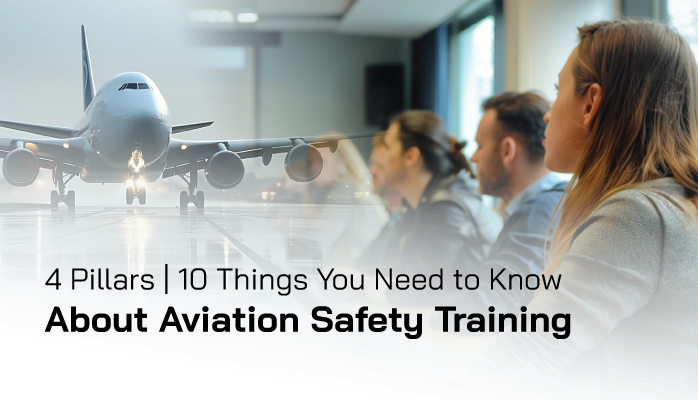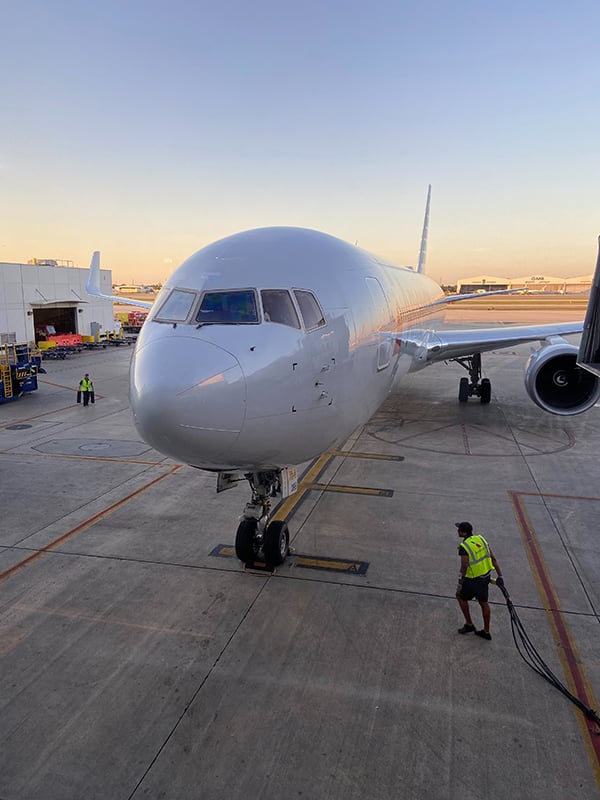What Are Safety Training and Education?

Aviation safety training and education is an essential building block for safety culture. Safety culture is understandably important for aviation service providers that are investing in aviation safety management systems (SMS). Without a healthy safety culture, SMS will never deliver the expected results and money will be wasted.
Accountable executives and safety teams must consider whether poor performance of their aviation SMS is a result of a lack of training, or a deeper, more sinister safety culture issue.
Safety training can make or break the successful performance of aviation SMS for:
- Meeting safety goals and objectives;
- Sustaining continuous improvement of the SMS;
- Ensuring return on investments for the aviation SMS;
- Ensuring consumer confidence in the company (i.e., lack of accidents);
- Developing a mature safety culture; and
- Ensuring regulatory SMS compliance.
Related Articles on Aviation SMS Training and Education
- What Is Aviation Safety Training in Aviation SMS - Includes Videos
- Why Employees Can’t Stand Aviation SMS Training
- 3 Critical Topics for Aviation SMS Training to Focus On
Safety training and education is not a simple topic when one considers the different aspects of:
- complying with regulatory compliance;
- methods of delivering SMS training;
- measuring the effectiveness of SMS training; and
- achieving maximum benefits from the SMS training.
The aviation industry is littered with so-called “training courses” that offer very little substance. This makes evaluating training options more difficult for safety managers who may be tasked with either:
- providing SMS training using in-house resources; or
- researching SMS training providers to deliver the training; or
- choosing a qualified SMS training company that fits your budget.
Why Is SMS Training So Important for Safety Teams?

Upper-level management may take a casual, nonchalant attitude toward SMS training. How hard is it to show employees:
- what is a hazard; and
- how to report a hazard; and maybe, just maybe
- what happens after they report a hazard?
This all sounds very simple, right? When things appear simple, we may discount their value to organizational effectiveness and maintaining a safe workplace for employees and customers. However, there is more for managers to consider.
Your accountable executive is responsible for ensuring the SMS is properly implemented and performed in all areas of the organization. In order for an SMS to appear as "performing as designed," there must be some way of measuring the performance of the SMS. Safety performance monitoring is critical to assure the accountable executive that "all is well" and when "all is NOT well," there must be some strategy to address the poor performance.
Reviewing the safety training and education of ALL employees is an important step in determining the root cause for the poor SMS performance. Your SMS needs a way to both deliver SMS training and measure the effectiveness of the training in order to evaluate whether training objectives and delivery are meeting the organization's SMS goals and objectives.
Related Articles on SMS Performance Monitoring
- 10 Great Reports to Monitor Safety Performance in SMS - With Examples
- Best Tip for Safety Assurance Monitoring in Aviation SMS
- 4 Tips to Monitor Employee Safety Performance in Aviation SMS
Below are 10 things to know about safety training for aviation service providers.
1 – Aviation Safety Training Is Safety Promotion
Safety training in airlines and airports is part of the Safety Promotion Element of the 4 Pillars of Aviation SMS. Safety training contributes to the promotion of the SMS and the development of the safety “mindset” in general. Safety promotion develops a safety culture. To continue to improve the SMS, you will need to break down the resistance of apathetic or openly hostile employees. Safety promotion can slowly change cultures which allows aviation service providers to maximize the utility of the SMS.
Safety training is the accountable executive's opportunity to bring employees from the dark side of non-performance to become active participants in the SMS. Safety training does not always have to be performed in sterile classroom settings. There are many ways to deliver training, each with its strengths and weaknesses, including the optimal time and place where these training nuggets can be disseminated to the organization. Be creative in your delivery, but make sure to document the SMS training so you can monitor the effectiveness of your delivery approaches and learn from mistakes.
Some alternatives for delivering SMS training include:
- Shared educational articles;
- Safety communications, such as memos or messages on bulletin board; and
- Informal information sharing during safety meetings and water-cooler discussions.
The above points promote the safety program and provide training in the process. Informal delivery of training is more difficult to assess for effectiveness, but please do not discount the effectiveness.
2 – Unconventional Sources of Aviation SMS Training
Aviation SMS training will also take the form of a "formal process." Most of you are probably thinking that this means attending a class, sitting down at a desk, and so on. This is an erroneous belief about formal safety training. What formal training actually means is that:
- The training is documented.
This is a much more flexible consideration of SMS training and allows many more avenues for training such as:
- Safety training articles (like this article, for example);
- Newsletters;
- Daily emails/messages about safety;
- And so on.
When we say that the training needs to be documented to be considered "formal training," this usually entails that the following data points are captured and tracked for further analysis:
- Training name (simple title);
- Training objective (optional, but nice for communicating the purpose to managers who may see this in future reports);
- Training date, or date range if a training campaign blankets a wider time period;
- Who received the training;
- Whether formal assessment given upon completion;
- How or whether training effectiveness is being monitored; and
- Any special remarks about this training.
If you do not track training, you cannot measure the effectiveness of a particular type of training. Why is this important? SMS performance monitoring is required for the accountable executive to fulfill his responsibility. When there is a sudden spike or drop in SMS performance, safety managers are better prepared to correlate causation to SMS training if these data points are captured for future trending analytics.
Trending charts can show changes in SMS performance over time. When safety managers can overlay training dates over the trending chart, this affords managers more assurance that a particular SMS training campaign "affected" the rise or decline in SMS performance.
Related SMS Trend Analysis Articles
- Aviation Safety Managers' Best Friend - Trending Charts
- How to Use Trending Charts in Aviation SMS
- Six Steps How to Perform Trend Analysis in Aviation SMS
3 – Who Needs Safety Training

Safety training is relevant to every level of an organization:
- Front line employees;
- Middle management;
- Executive management; and
- Contractors and part-time employees.
Every level of an organization will have different safety concepts that are most relevant. All employees should receive regular SMS training and this training must be documented.
4 – Signs of Good Aviation Safety Training
Not all aviation risk management training is created equal. Training prices vary quite a bit, and the quality of safety training varies even more. Expensive safety training does not necessarily mean good safety training.
When evaluating the quality of risk management training, here are things to look for:
- Reviews from previous customers;
- Documented remarks from previous courses the provider may have delivered at your organization;
- Pre training assessments;
- Practical application of ideas rather than definitions or concepts;
- Topics that are relevant to your aviation SMS;
- Hands-on training, stresses “doing” rather than “listening”;
- End of course assessments; and
- Take home materials.
Overall, good aviation safety training aligns training points with your current operational risk management practices. Unfortunately, most training courses are not designed with this in mind, so choose carefully.
In order for the training to resonate with employees, the trainer should have experience "talking the talk" expected in your type of operations. For example, an SMS trainer with an airport background would naturally be suited to speaking with an airport audience. Conversely, there are SMS trainers who have incredibly broad ranges of expertise and are equally adept at speaking to aviation maintenance organizations as effectively as talking to airline employees. This is an important consideration as it affects how well students will internalize the delivered SMS training.
More Articles on Aviation SMS Training and Education
- 3 Biggest Aviation Risk Management Training Mistakes
- Aviation SMS Training - Meet Your Objectives Easily - With Templates
- How to Be Compliant With ICAO Training and Education Requirements
5 – Top Safety Training Mistakes
Training mistakes in aviation are all too common. These mistakes totally undermine the purpose of safety training, and can even have a negative effect on SMS performance and safety culture. Some top mistakes are:
- Training is boring;
- Training is far too conceptual;
- Training doesn't highlight benefits to the employee (what's in it for the employee?);
- Course material is not evidently applicable (how does this stop "The Accident?"); and
- No competency testing.
The above mistakes give strong incentives to not pay attention or care about safety training. Ensuring that training is based on the application of concepts, is fun/interesting/entertaining, and includes competency testing are great ways to amplify the positive effects of training.
6 – Aviation Risk Management Training May Not Improve Performance

Just because employees attend safety training does not mean that it will have any positive effect on safety performance. Unless the training program goes above and beyond the standard, it will have little impact on safety performance. It will, however, allow you to "check the box" for safety training compliance.
So what are your priorities? If you aim to actually improve aviation SMS performance, then choose your training course wisely, such as training with the following elements:
- Hands on;
- Interesting;
- Scenario/activity-based; and
- Relevant.
Most training does not fulfill these requirements, which is why most safety training will do little to improve safety performance. So don’t make the mistake of automatically assuming that safety training will improve performance in your program when – oftentimes – it, unfortunately, isn’t true.
As mentioned earlier, in order to evaluate whether training is actually meeting your safety goals and objectives, then you need to monitor SMS performance activity before and after delivering the training. If your goal is to merely "check the box" for your "paper SMS," then don't worry about tracking SMS performance relating to training. Why am I saying this?
Having a "paper SMS" is not always a bad thing. SMS purists may frown at me for saying this, but aviation is a commercial endeavor. Stakeholders are investing money and time into the operation. There will be times when you only need to display "evidence" of an SMS without really having the labor pains of giving birth and the pains of raising your SMS baby. To satisfy short-term business goals, it makes complete sense to have the paper SMS without jeopardizing stakeholders' capital.
This is the short game. Based on experience, I have seen operators sail past SMS auditors for four to six years before the "hammer falls." Only then, will these operators be forced to either:
- sincerely implement the SMS and monitor performance; or
- stop operations.
Those four to six years may afford aviation service providers time to:
- focus on business objectives; or
- wait until they have time and resources for a regulatory-compliant SMS.
This is the business decision that would benefit the adoption of the "paper SMS." Based on over a dozen years of observations, I believe this business tactic is more common than the aviation industry cares to admit. If I were to venture a guess of how many aviation service providers have a paper SMS, I would say between 25-40%. What do you think?
This revelation may cause you to roll your eyes in disbelief. If you feel otherwise, please leave a comment. I doubt many regulatory authorities will admit this, but they certainly see it in action. However, this is not necessarily a bad thing from the perspective of civil aviation authorities (CAAs). SMS requires a major cultural shift and if you can get operators to "fake it" for a few years, some of these organizations with paper SMS will slowly come around. Fake it until you make it!
Have a paper SMS? Don't worry. Keep at it long enough, and your "may" blossom; however, an SMS won't happen by itself. Somebody has to take the reins and make it happen. Who? It should be the accountable executive, as SMS is implemented most successfully from the top down.
Fake it until you make it!
Related Articles on Aviation SMS Implementation
- Is Your Aviation SMS Implementation a Farce?
- Why Should We Implement Aviation SMS?
- 4 Tips to Approach Hazard Identification in Aviation SMS
7 – What Defines Good Safety Training
Good safety management training does the following:
- Cultivates knowledge about safety events;
- Empowers employees to operate safely;
- Develops a proactive risk management culture;
- Strengthens or reinforces safety culture; and
- Safety managers can actively monitor the results of good safety training.
Good safety training courses are defined by being:
- Hands-on as opposed to conceptual;
- Practical application as opposed to definition based;
- Relevant to your SMS and type of operations;
- Features end of course assessments;
- More active and less listening;
- Includes take-home materials for reference; and
- Effective in positively influencing SMS performance.
8 – How to Monitor the Effectiveness of SMS Training
The single best way to monitor the effectiveness of SMS training is through pre-course and end-of-course assessments. This will allow you to assess the quality of a particular training course.
Next would be to monitor:
- Results of end-of-course assessments;
- Timeline of other safety training activities (such as newsletters, etc.); and
- Comparing this against the timeline of leading indicator performance or performance of key performance indicators (KPIs).
Related Articles on Key Performance Indicators (KPIs) in Aviation SMS
- What Is a Key Performance Indicator (KPI) in Aviation SMS?
- How to Set and Monitor Key Performance Indicators (KPIs) in Existing SMS
- How to Automate Key Performance Indicator KPI Monitoring
9 – Why Employees Can’t Stand Aviation SMS Training

The unfortunate fact is that many employees don’t like aviation SMS training. This is usually because:
- There nothing in it for the employees;
- They become blind to recurrent training that is the same; and
- It’s not personally relevant.
Training should answer three basic questions for employees:
- Why should I care?
- How does this training help me perform my job?
- Is this interesting?
When employees have positive answers to these questions, it will tend to give them a reason to at least tolerate the training.
10 – Satisfying Compliance for Aviation Safety Training
Aviation SMS must develop and maintain a safety training program to ensure that employees are competent to perform duties and fulfill their responsibilities to the SMS.
Compliance with this requirement is indicated when:
- There is a documented process to identify Safety Management training requirements so that personnel are competent to perform their duties;
- There is a process in place to measure the effectiveness of training and to take appropriate action to improve subsequent training;
- There is a process that evaluates the individual’s competence and takes appropriate remedial action when necessary;
- Training includes initial and recurrent training; and
- A training record is maintained for all personnel trained.
Automating SMS Training
SMS training does not have to be difficult, expensive, or exceedingly time-consuming. A best practice is to automate as many of your training processes as possible, yet still, conform to SMS training requirements. Automated, computer-based training provides many benefits to aviation service providers. When your automated SMS training is integrated with your SMS database, you will really be able to take your SMS to the next level.
With automated training, records are maintained and management is assured that SMS training is not falling through the cracks. Furthermore, monitoring SMS performance after training is much easier than trying to use spreadsheets.
Your accountable executive is responsible for regularly reviewing safety performance. His monitoring tasks will become more sustainable and more accurate when conducted using automated tools integrated into an SMS database.
For high-quality risk management training tools, see the videos below. You can use these videos to automate your SMS training. These videos were designed for aviation safety professionals by aviation safety professionals.
Get Fully Automated SMS Training
Are you interested in moving away from your paper SMS? We have tools to take your SMS to the next level. Explore these short demo videos to see whether we are a good fit for you.
Last updated in December 2024.







